The Metroid Prime trilogy, arguably the best gaming trilogy ever, has just been re-issued as a $US20 download on the Wii U. That’s a good reason for Kirk “never played a Metroid Prime” Hamilton to try them out. I had to see how that went.
What follows is an early report of Kirk’s findings, an enjoyable and illuminating conversation about a game in a series Nintendo has neglected for too long. We had this chat late on Friday after having both played the first part of the first Prime on our respective New York and Oregon-based Wii U video game systems.
Kirk: It sure seems good so far! Granted, I’ve only played a few hours. But right from the start, it’s sure of itself in that way that good Nintendo games usually are. I feel like I can relax and trust that I’m in for a good time. As long as I get my Wiimote working.
Stephen: Yeah, having to go back and play a game with a Wii Remote and Nunchuk wasn’t ideal. I don’t think of myself as a lazy gamer, but having to sit up straight and point that Remote? It felt weird. Maybe partially because I originally played the first two Primes on the GameCube with a pretty standard controller!
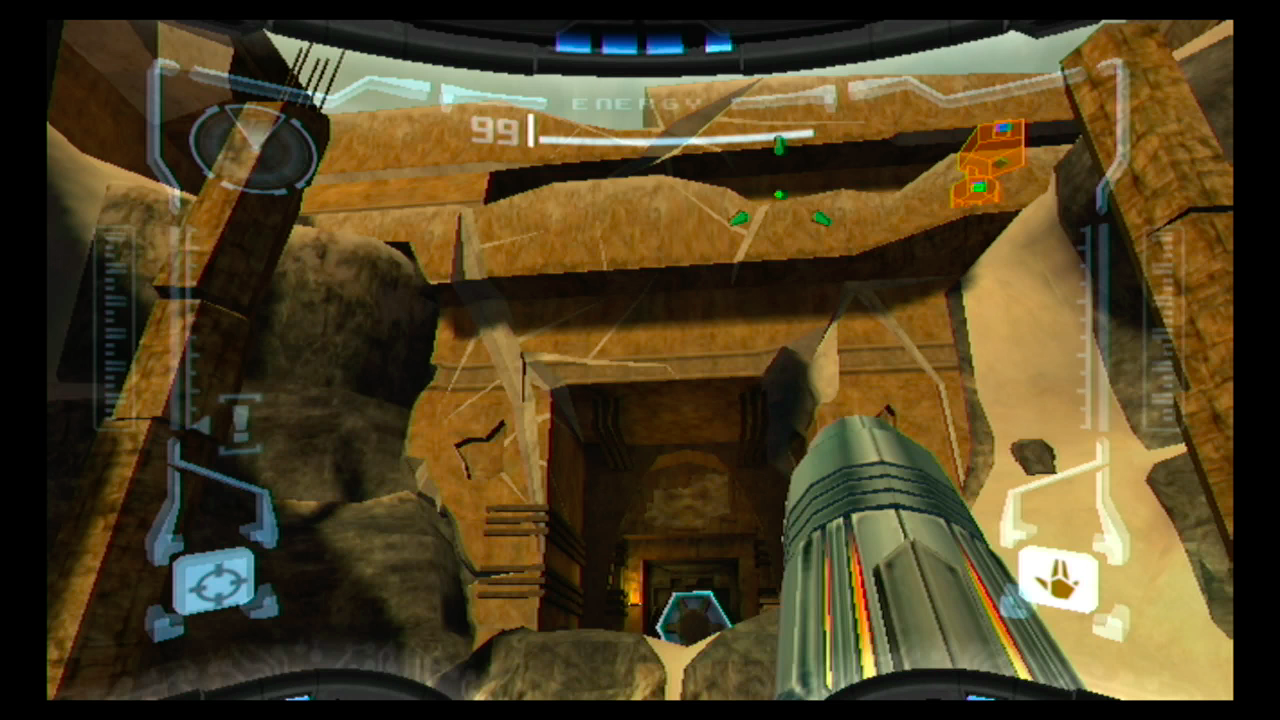
Kirk: Right, I keep thinking about how it’d be to play it with an ordinary controller. I actually think that in the long run, I’m going to really like the motion controls and that part of the issue is that I can’t figure out how to re-calibrate the Wiimote mid-game. So, I wind up sitting mostly comfortably, but holding my controller at a sliiiiightly weird angle, so my wrist gets tired. But whatever, I’ve moved my sensor around a bit and gotten mostly comfortable. Setting it to “advanced” controls helped a lot, too.
Stephen: I think the Wii Remote Plus is smarter about keeping you properly tracked.
Kirk: Smart enough, anyway. But I don’t want to get sidetracked by the pros and cons of motion controls. The game! This is apparently the greatest game ever made, right? I don’t even know what I’m in for? Something like that?
Stephen: But the thing is, back on the GameCube, Prime was specifically presented as NOT being a twitch-based shooter. That’s why they have the lock-on and stuff. It’s more of a sci-fi detective kind of game, after all — mixed with sci-fi archaeology.
They tried to market it was a first-person adventure. Silly as that sounds, I love the distinction, because I love the way Prime plays. You land on the planet and, for me, it’s not about finding stuff to kill, it’s about scanning plants and animals, reading the ancient scripts on the walls, studying the architecture, trying to figure out how this world works and how you can sort your way through it.
And, yeah, it winds up being one of the greatest games of all time.. if you’re into that kind of thing.
Kirk: I do like great games.
Stephen: Do you at all sense you’re playing an all-time great? Or just a well-made game? Like, are you chuckling to yourself as you play? “Ah, those Nintendo kids were blown away by THIS?”
Kirk: So far, it seems like a well-made game, but I haven’t unpacked the greatness. It seems dated in some ways, but mostly has that timeless Nintendo “thing,” where everything in the game feels of a piece, the feel and controls are distinctive and solid, and the whole thing is well-designed to keep me moving forward. (The scanning and the various databases feel different from other Nintendo games I’ve played, so that’s one place it stands apart.) So far, it’s unfurling organically, and I can see how it (I guess?) eventually becomes this interlocking series of tunnels and arenas, folded and re-folded onto itself.
I get what you’re saying about it being more an adventure game than an action game. It’s certainly grabbing me more as the former than as the latter. Some of the action isn’t entirely smooth for me, yet, partly because I’m still adjusting to the controls, and partly because it’s difficult to pull off reaction-based shooting with muddy, low-res textures. Those big flying bee creatures, in particular, kinda blend into the background. And I had to laugh that one of the first mini-bosses I fought in this alleged masterpiece was a “charging bull” monster that I had to dodge, then shoot in the back after it crashed into the wall behind me. I guess that wasn’t as hackneyed when this game came out.
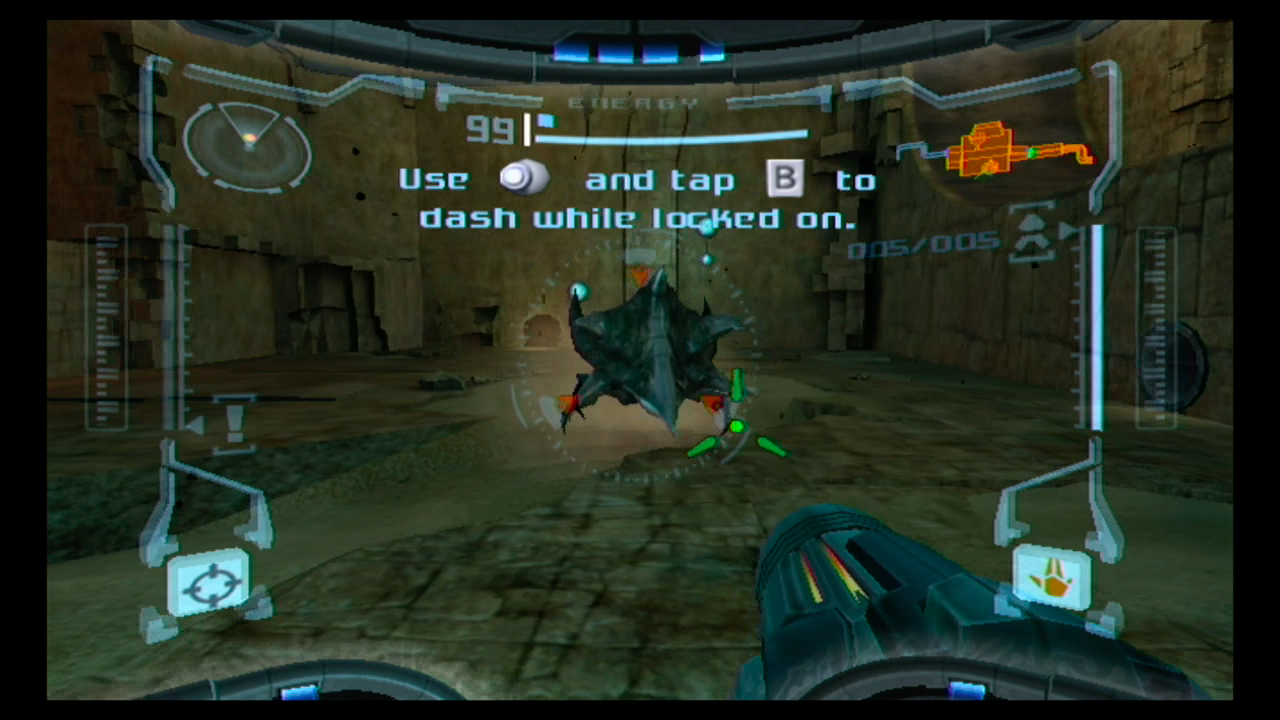
But yeah, the exploring is great. Am I crazy in thinking that the map is exceptionally good? I’m already using it constantly, when most 3D video game maps take forever for me to figure out.
Stephen: I hear you about that first mini-boss. In fact, I think that the fight against the little flying creatures right before you get the first missile container is pretty poor, too. Again, the game wasn’t originally designed for twitchy pointer controls. It was single-analogue. You used the GameCube controller’s c-stick to change weapons; you could only do free-looking if you stood still and pressed a button. The action was very much about locking onto an enemy and shooting it, strafing it as you locked on. That first mini-boss was likely a way to teach you how to lock on effectively. Because, really, the game wasn’t a test of your physical reflexes; it was a test of your mental agility — your ability to figure out which weapons, items and visors to use and how to eventually get everything out of each of the game’s rooms.
Have you noticed buzzing sounds or low hums in a lot of the rooms you’re in? They represent hidden things in the rooms, and you really have only finished a room once you’ve pretty much quieted the room down. What they’re doing is asking you to pay attention, to look at everything, listen to everything and then act.
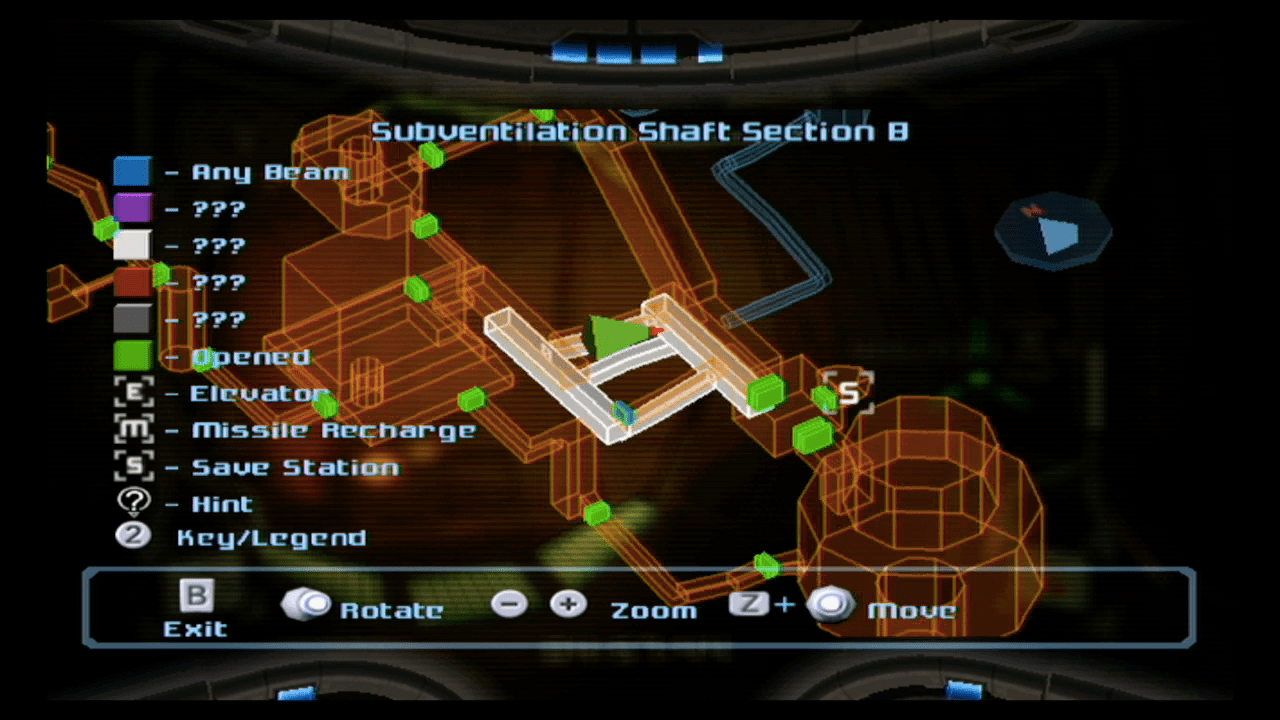
Given that that’s their design, they have to do a couple of important things. One of them is to give you a very clear and comprehensible map, which they do. It makes a lot of sense, loads fast, is easy to zoom and rotate and is well-marked. Two, and way more important, is that they have to give you rooms — a world, really — that are full of interesting and distinct things to look at and listen to. And that is where I think the game finds the most success.
The game’s art and sound design are nearly unparalleled in gaming. I marvel not just at how well the game holds up visually but how much of that is due to the studio, Retro’s, masterful illustration of each room. This is a game where even the hallways are interesting to look at and tell some sort of story about the culture that carved them.
If the art direction isn’t doing it for you, you’re not going to like the game. But I do hope you’ve picked up on that, that every room is distinct. I don’t think they repeat anything other than doors in terms of the assets they use from room to room.
Kirk: The audio is incredible. And Kenji Yamamoto’s music! Both just so, so good. As I was escaping the pirate ship in the prologue, I was certain the “Escape!” music was playing a busy signal. I have a note that says “Is this a busy signal?” And it totally is, check it out.
So good! Not many video game soundtracks are that good.
I’m sensing some of the smart things you’re talking about with the design and how it signposts things, but not all of it. Lots of games have lifted that sort of design, obviously, in the years since Metroid Prime came out. The idea of walking into a room, seeing a door you can’t open and thinking “OK, I’ll just come back and open it when I’m able.” But Metroid has an unusual amount of subtlety going on with all that. It’s a remarkably subtle game in general, really. I’ll have to pay more attention to the audio cues you’re talking about — I’m sure there are a lot I’ve been missing.
Have you found yourself approaching the game differently now than you’d imagine I am, as a newbie? Do you do some things first, since you know what’s coming, or is the path the game carves for you generally still the thing to stick to, at least at first?
Stephen: I have the advantage of knowing how much I can’t do yet. Like most of those audio cues? You can’t do anything about them. Now that you’ll be listening for them you’ll notice where they are coming from, and you’ll realise how many parts of the rooms that you’re in are out of your reach.
And this is where Metroids make or break players, because some gamers loathe the concept of having to backtrack. Me? I love going back to one of the game’s starter areas, now with a radically different power set, and getting past previously un-passable obstacles.
Kirk: Oh yeah, I’m the same way. Partly because games have trained me to be, I think!
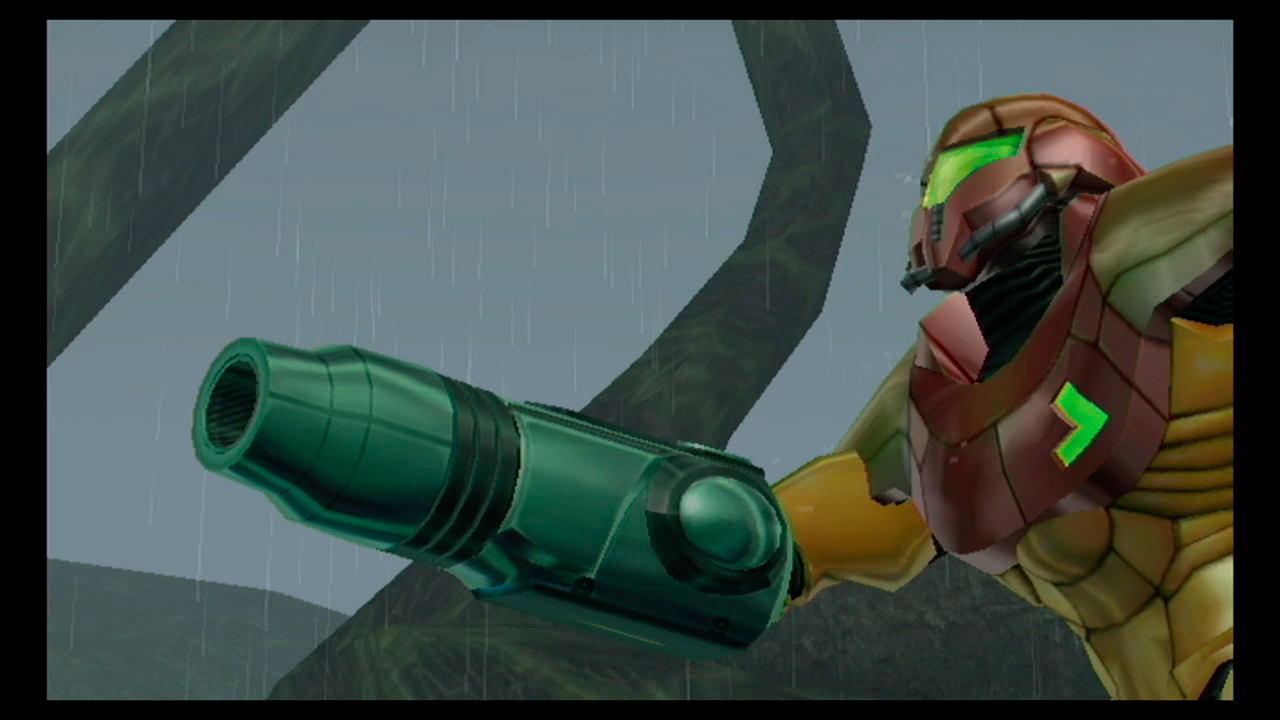
Stephen: One huge thing that will be lost on you is the historical impact of the game for people who grew up with Nintendo.
Kirk: It comes across, at least a bit. You mean that it’s a FPS?
Stephen: You had all these 2D games in the NES and SNES, right? Mario, Zelda, Metroid were three of the top games.
The N64 comes around, PlayStation is already clearly beginning to kick Nintendo around, and yet Nintendo figures out this thing where they can take a beloved 2D franchise and through the magic of polygonal graphics, put you in. Mario, but in 3D! You are IN the Mushroom Kingdom.
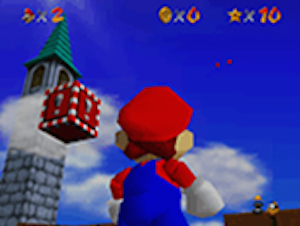
And so they do this for Mario and make arguably the best game ever. Then they do it for Zelda and top themselves, some would say.
But they go the whole N64 era with zero Metroid games on console.
And then they go to the GameCube and we’re in the moment of GTA and Final Fantasy X and all that, and Nintendo finally brings Metroid back, but… as a first-person shooter… largely developed by Americans.
So you have this very weird back-story, all these reasons to be sceptical, but the magic of the game for people who had been on that journey is that they do that magical thing again. They take a character and a world you only ever saw in 2D and they put you in it.
In fact, they put you even more in it, by putting you in Samus’ suit!
That’s hugely impactful and might be akin to finally going to the movie version of a novel you loved.
But, you, Kirk, you didn’t read the Metroid novel, so you’re like, whatever.
Kirk: Hahaha.
Stephen: The space station prologue is a terrific microcosm of the game, though. It doesn’t teach you backtracking, but it really sets the Metroid mood. You’ll fight a little, explore a lot, and you get to be a cool, silent lady bounty hunter in the process… though I guess there’s some looping back in it… not quite backtracking.
Kirk: I do get that part of it — I wasn’t a Nintendo Kid growing up, but I played Metroid on Game Boy, and loved the heck out of it. I can get how people would have thought it was amazing to step into Samus’ suit, to see through her visor. Plus, the game does a really good job of putting you in the suit in subtle ways. The way she uses her other hand to steady her gun arm when she shoots, how it places various things around on her HUD.
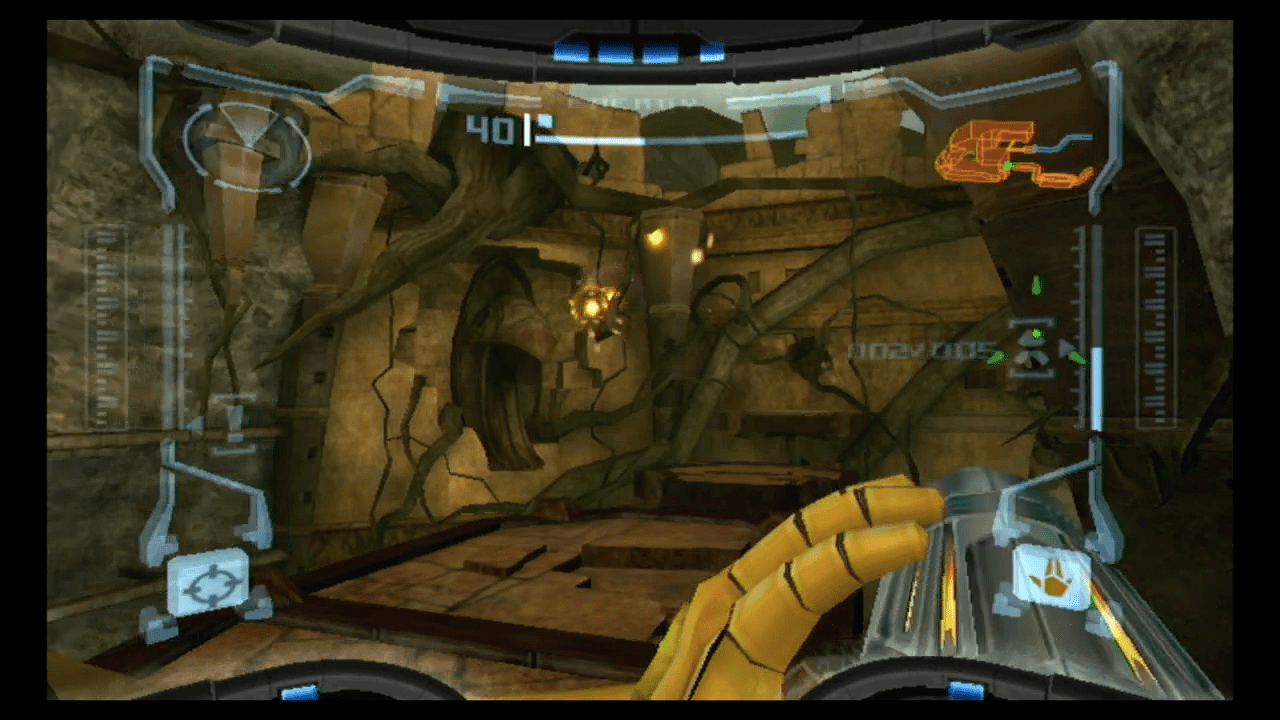
Samus really is a fascinating character. So many thinkpieces have already been written about her, and I wouldn’t dare try to add anything substantive at this point, but I do get a sense of her character from small things in the game. Related to that, a question: Do you think that the text that pops up when you scan something is her? Or is it just her computer? I keep feeling like I’m getting a small sense of her personality from each of those blurbs, but maybe I’m misreading it.
Stephen: Oh, I don’t read those as her. I read them as her computer or the spaceship (maybe one and the same). I am a scanning maniac, by the way.
Kirk: I keep forgetting to!
Stephen: I don’t know why I love scanning. I’m not usually a lore person.
Kirk: Maybe because they make it active?
Stephen: Yeah. Maybe it’s because you get the lore with little interruption.
Kirk: So all Dragon Age had to do was make your Inquisitor take out a magnifying glass in every scene and manually dig up lore entries. Problem solved!
Stephen: Yeah, that would be nice. The scanning teaches you a lot more about the world.
Kirk: The scanning is indeed cool. I played a bit of Hunters on DS a looong time ago, and I remember finding the scanning charming even in that game. I like games where you can hit a button and get a “new” view of the world you’re already in. Which makes me think… was Metroid’s scanning visor a precursor to Arkham Asylum‘s detective mode? It’d be interesting to look at all the ideas this game had that turned up in later games.
Stephen: Hunters was horrible. It’s barely a Metroid game.
Kirk: Ha, I thought people liked it! I didn’t play much.
Stephen: But you know the lead game designer and art director of the Prime games made that Batman Arkham Origins Vita/3DS game? Which is why it’s so Metroidy. Not as good a setting or moveset, though, so I didn’t feel like they got to strut their stuff as best they could.
To wind things down, let’s discuss the magnificence of the morph ball. You’re essentially also playing one of the, if not the, finest Transformers games ever made.
Kirk: Yeah, the morph ball is great. I just re-got it, and am glad to have it — though I already miss the ability to blow things up while in ball-mode. I like that it makes the game into a hybrid first- third-person game, which opens up all sorts of different possibilities for puzzles and exploration. Halo sort of did the same thing in 2001, but the third-person camera wasn’t something you could toggle on and off like you can in Metroid.
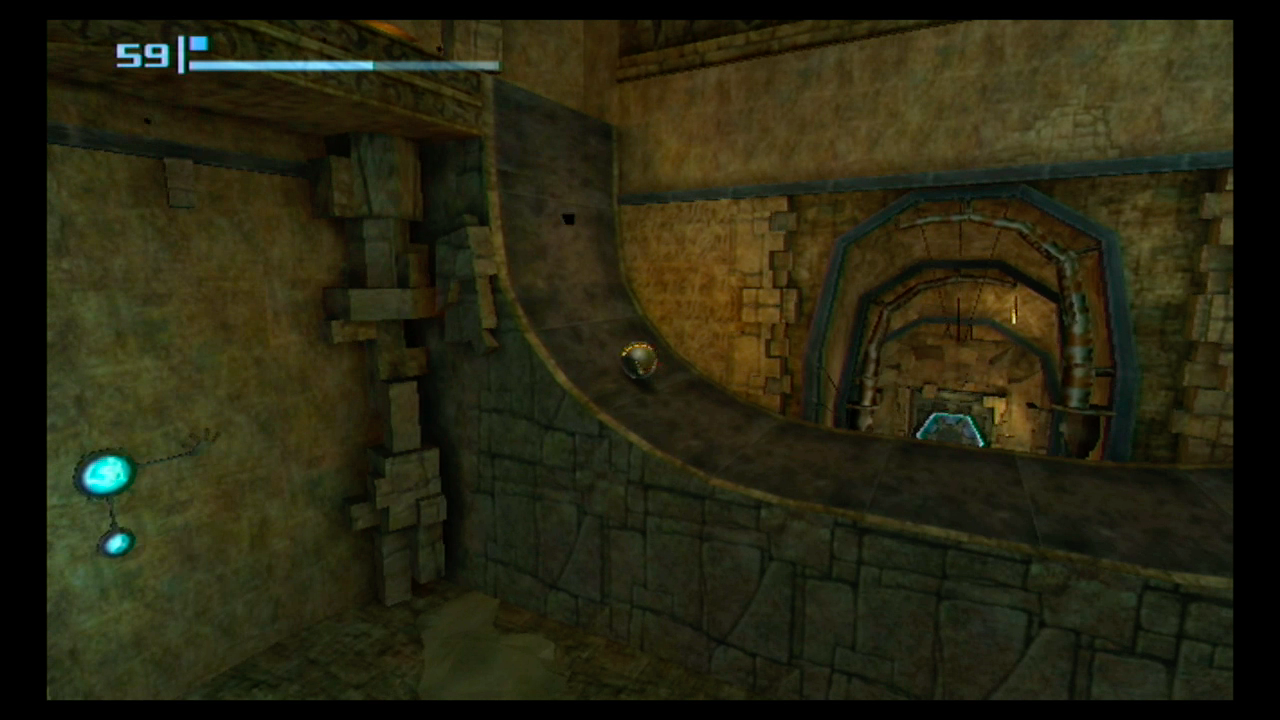
Stephen: Yeah, it’s a credit to them that they pull off the morph ball without making the whole thing look absurd. It’s one of the last vestiges of the goofy movement ideas you’d get in 2D games that was effectively brought into 3D gaming.
I wonder if you noticed some half-pipe-looking parts of the rooms you were in. Imagine if there was a way to use them with the morph ball. Hmmm. You have so many awesome things to discover!
Do you think you’ll keep playing?
Kirk: I do! You know me, I’ve always got too many things to play, but something about having this entire trilogy right here is too enticing. Not only does it feel like an important missing piece in my “I can’t believe you haven’t played that” backlog, it sounds like all three games are really fun. So yeah, I’ll keep playing as long as I’m having fun, which I sense will be until I finish.
Do you think you’ll keep playing? If so, maybe we can circle back once we’ve both played more.
Stephen: Yeah, I usually don’t re-play old games, because I’m sceptical about my enjoyment of them and am convinced that most older games were products of their time that have been improved upon in terms of design and hospitality to the player. But I’ve loved my return playthrough of Majora’s Mask on 3DS, and I’m delighted with my time back in Metroid Prime. I’ve tried to go back to them before and always stopped somewhere in the first game.
I know that Prime 2 is the least-loved entry of the series, but I remember liking it the most (of course). It has the most visually-striking area of the entire series and also the most unusual visor mode that I can’t wait to re-experience.
I want to play all three all over again, so, yeah, I’m back in — if a bit bummed that I can’t play these Wii U games on the GamePad with the dual-analogue controls. Oh well.
Let’s definitely do this again when you’re further in. How about this. Let’s not do it again until you see Samus’ face. That’s a teaser for you!
Kirk: !!!! OK, sold.
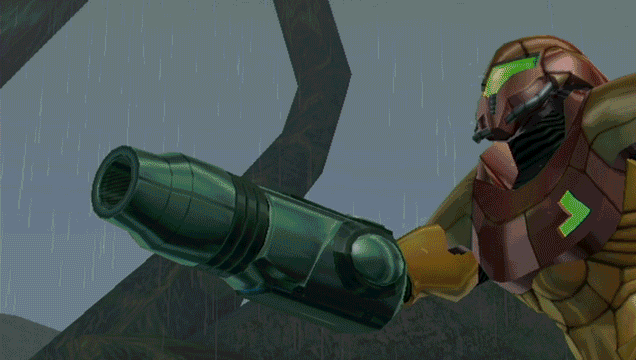
Comments
6 responses to “What’s So Great About Metroid Prime”
This was a good read.
This was a good read.
I really thought there was a glitch in the Matrix there for a second!
I really thought there was a glitch in the Matrix there for a second!
What are you guys talking about?
What are you guys talking about?
I find the split controller nature of the wiimote to be even more comfortable than the gamecube controller, able to aim completely with the wiimote hand resting on my knee.
Traversal is silky smooth compared to the gc version, you can just soar through the platforming sections.
The option for traditional controls would have been nice, but it would only have worked for the first two games. It’s probably better to maintain consistency.
Great games, all of them. So worth it, especially at the launch discount price. I bought it even though I had it on disc, the new loading times are phenomenal!
But I did have to move the game from my external drive to the system memory to get it to work! And it still had a hard crash during echoes. I’m not sure what’s going on, I’ve never experienced so much as a glitch in any previous version of the games.
If you have the basic system be wary, as it won’t fit onboard! None of my downloaded wii games work from any external drive for me (two hdd’s and a thumb drive for hood measure), and I’m not an isolated case!
Damnit. Stop reminding me that I can buy this. It’s like a puppy. I really want one but I just don’t have the time to give three Metroid Prime games the love and attention they deserve. =(
You make time.
You make time.